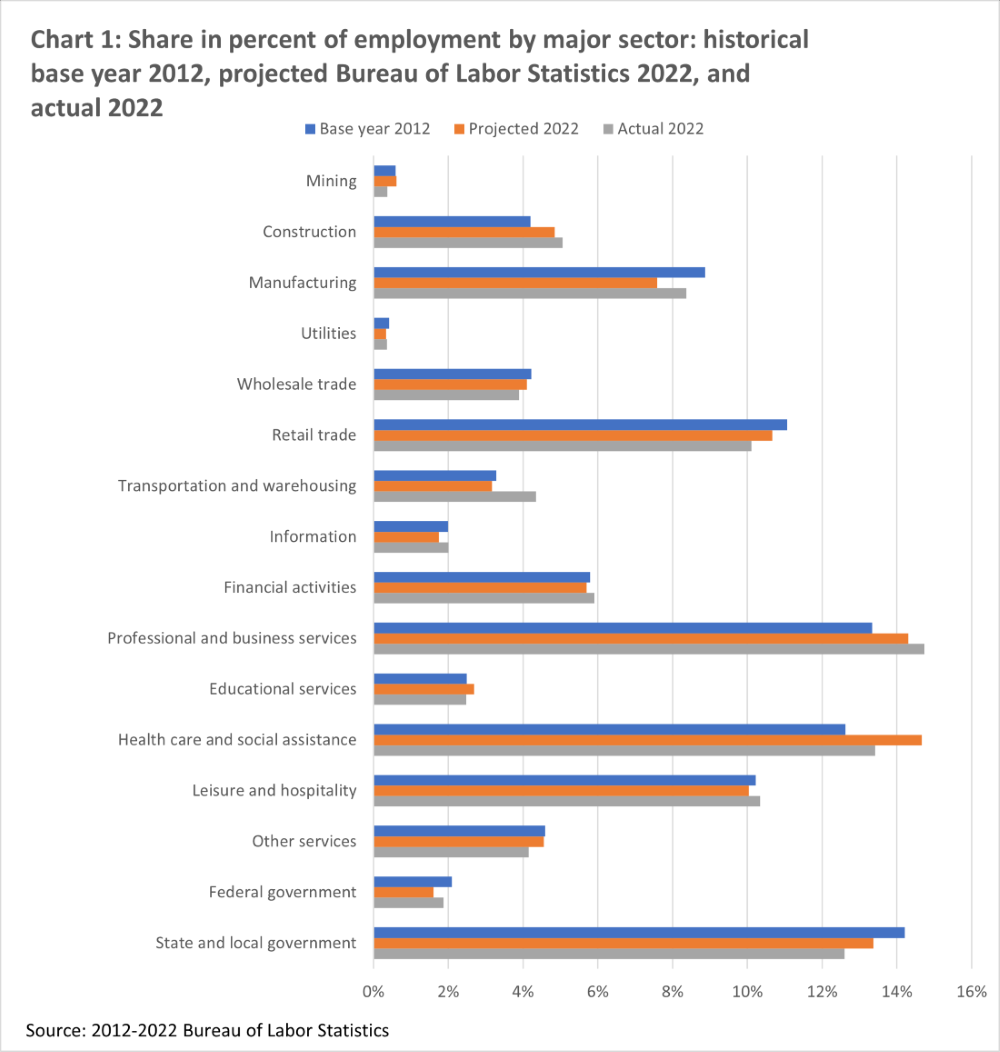An official website of the United States government
 United States Department of Labor
United States Department of Labor
BLS estimated models for roughly 200 detailed industries that were then summed to sectors and major sectors.1 Detailed industry projections were constrained to sum to the total nonfarm wage and salary employment provided by the macroeconomic model.
How often did BLS correctly project growth and decline for industries?
BLS correctly projected which major sectors would grow and which would decline 75 percent of the time.
The service-providing sector, representing over 80 percent of U.S. employment, was correctly projected to experience continued growth over the 2012–22 decade. Within the service sectors, 11 sectors were correctly projected to grow or decline; however, information and federal government were both expected to decrease, but instead experienced growth. While BLS correctly predicted that the goods-producing sector as a whole would increase, BLS incorrectly predicted that mining would slightly increase, and manufacturing would slightly decrease. Instead, mining saw an employment decline, and manufacturing saw employment growth. Construction was correctly projected to grow.
What did BLS project as the nonagriculture wage and salary compound annual rate of growth from 2012 to 2022?
The projected compound annual growth rate from 2012 to 2022 was 1.1 percent.
What was the actual nonagriculture wage and salary compound annual rate of growth from 2012 to 2022?
The actual compound annual growth rate from 2012 to 2022 was 1.3 percent.
For each of the following measures the BLS projection was compared against this naïve model.
| Sector | Actual 2022 employment | Employment projection | Absolute percent error | Best performer | ||
|---|---|---|---|---|---|---|
| BLS | Naïve | BLS | Naïve | |||
|
Nonagriculture wage and salary |
153,186 | 149,751 | 135,417 | 2% | 12% | BLS |
The BLS model was much closer to the actual 2022 employment than the Naïve model for total nonagriculture wage and salary employment. (See Table 1.) The BLS model also outperformed the Naïve model in most of the major sectors in the absolute percent error measurement. (See Table 2.) The major sectors where the BLS model did not outperform the Naïve model are utilities, educational services, health care and social assistance, leisure and hospitality, other services, and federal government.
| Sector | Actual 2022 employment | Employment projection | Absolute percent error | Best performer | ||
|---|---|---|---|---|---|---|
| BLS | Naïve | BLS | Naïve | |||
|
Mining |
560 | 922 | 1,044 | 65% | 86% | BLS |
|
Construction |
7,748 | 7,263 | 4,216 | 6% | 46% | BLS |
|
Manufacturing |
12,826 | 11,369 | 7,657 | 11% | 40% | BLS |
|
Utilities |
554 | 498 | 517 | 10% | 7% | Naïve |
|
Wholesale trade |
5,963 | 6,143 | 5,559 | 3% | 7% | BLS |
|
Retail trade |
15,475 | 15,966 | 14,288 | 3% | 8% | BLS |
|
Transportation and warehousing |
6,651 | 4,742 | 4,476 | 29% | 33% | BLS |
|
Information |
3,074 | 2,612 | 1,955 | 15% | 36% | BLS |
|
Financial activities |
9,045 | 8,537 | 7,553 | 6% | 16% | BLS |
|
Professional and business services |
22,572 | 21,413 | 19,134 | 5% | 15% | BLS |
|
Educational services |
3,795 | 4,022 | 4,001 | 6% | 5% | Naïve |
|
Health care and social assistance |
20,555 | 21,966 | 20,570 | 7% | 0% | Naïve |
|
Leisure and hospitality |
15,835 | 15,035 | 15,156 | 5% | 4% | Naïve |
|
Other services |
6,363 | 6,823 | 6,082 | 7% | 4% | Naïve |
|
Federal government |
2,869 | 2,407 | 3,009 | 16% | 5% | Naïve |
|
State and local government |
19,302 | 20,032 | 20,199 | 4% | 5% | BLS |
Comparing the projected share of the labor market with the actual share helps to address whether BLS correctly advised career-seeking customers which industry to pursue. (See Chart 1.)

1Sectors and major sectors are aggregations of NAICS industries.
Return to Projections Evaluation Homepage
Last Modified Date: January 19, 2024